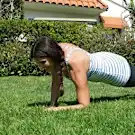5 STRETCHES YOU SHOULD NOT DO BEFORE
WORKOUT
These moves are doing your body no favors.

GETTY IMAGES
Pop quiz: Should you always stretch before a workout? If your answer was “stretch,” you’re half right. You should never start exercising without stretching, because “muscles need to be warmed up in order to increase your heart rate, which translates to increased blood flow, and therefore oxygen, to the muscles,” , an AFAA- and NASM-certified trainer and the founder of A.C.C.E.S.S., an active recovery fitness class. “And you want more oxygen in your muscle cells to assist in the stress you’re about to place on them.” But the type of stretching you do matters, a, or moving stretches, should be your go-to before a workout. As far as static stretching goes (a.k.a. holding a position for 30 seconds or longer), you’d be better off skipping that warm-up, accor “Static stretching prior to a workout reduces muscle strength, decreases muscle power, and impairs explosive muscle performance,” says physical therapist Christina Ciccione, C.S.C.S., the clinic director at “Static stretching can ultimately damage your muscles or tendons when performed before the muscles are adequately warmed up.
The five positions below are the most commonly misused stretches pre-workout, according to Kennedy. Nix them from your routine and warm up instead for five to 10 minutes with dynamic stretches, light aerobic work, you can always go for the static stretches post-workout!
1
ELEVATED HAMSTRING STRETCH
This is when you place one foot on a surface slightly lower than your hip, like a bench, and flex your foot before hinging at the hips to bend toward your flexed foot. This stretch often leads to a deep burn in the back of the knee, which you might translate as a good stretch. “In reality, this sensation is only tension being applied to the sciatic nerve,” explains Ciccione. “The hamstring isn’t actually increasing in length or becoming more flexible."
2
FORWARD FOLD
You know this one from yoga: You stand with your feet together, hinge at the hips, and bend forward to reach palms toward the floor. “The hamstrings are a huge muscle group assisting in squats, deadlifting, running, and lunging,” says Kennedy. “A static hold could make them less efficient during training and potentially lead to painful injuries like microtears, which could limit your movement.
MORE CONTENT
 Top 5 Best Free Virus Protection 2017My Antivirus Review
Top 5 Best Free Virus Protection 2017My Antivirus Review What's Better For Your Body: Yoga Or Pilates?Women's Health
What's Better For Your Body: Yoga Or Pilates?Women's Health Biosurfit, Axon Lab Reach Distribution Deal for Switzerland360dx.com
Biosurfit, Axon Lab Reach Distribution Deal for Switzerland360dx.com 4 Reasons Why Pushups Aren’t Getting Any Easier, No Matter How Many You DoWomen's Health
4 Reasons Why Pushups Aren’t Getting Any Easier, No Matter How Many You DoWomen's Health Werde Teil der Mars Network Challenge von Cisco und helfe dabei, die menschliche Präsenz auf dem Mars auszubauen.Cisco
Werde Teil der Mars Network Challenge von Cisco und helfe dabei, die menschliche Präsenz auf dem Mars auszubauen.Cisco 6 Trainers Share the One Workout Move They Can’t Live WithoutWomen's Health
6 Trainers Share the One Workout Move They Can’t Live WithoutWomen's Health
FEAR OF MISSING OUT?
DON'T MISS OUT ANYMORE!
You may unsubscribe at any time.
3
STANDING ISOLATED QUAD STRETCH
This is a classic stretch, where you start in a standing position and grab one foot with the same-side hand, keeping your thighs aligned. But “the standing quadriceps stretch is often performed incorrectly and puts too much stress on the knee joint, causing anterior knee pain,” says Ciccione. “Anterior knee pain can indicate patellofemoral joint issues—“which you should try to avoid.”
FIGURE 4
In Figure 4, you’re either lying on your back with your legs bent, one ankle resting on the other thigh right above the knee, or standing on one bent leg with the other crossed over it, ankle resting on thigh. “This position requires hip flexion, abduction, and external rotation in order to get into the proper stretch position, but prior to your workout, when the muscles haven’t had an adequate warm-up, the hip doesn’t have the range of motion, and the muscles surrounding the hip joint don’t have the adequate flexibility to target the glute muscles you’re trying to stretch,” says Ciccione. “It’s a waste of time,” says Kennedy.
5
PIGEON POSE
Ah, pigeon. The goal of this hip opener—with one leg bent and parallel to the top of a mat and the other extended straight behind you while your torso hinges over your front leg—is to stretch the piriformis muscle and the external rotators of the hip. But “forcing this position with a fixed object, the floor, can torque your knee or ankle,” says Kennedy. Plus, “getting into pigeon pose involves several other muscles in the pelvis, hip, and knee,” says Ciccione. “If those muscles are tight, the stretch is often

No comments:
Post a Comment